A Guide to the Medieval Longsword
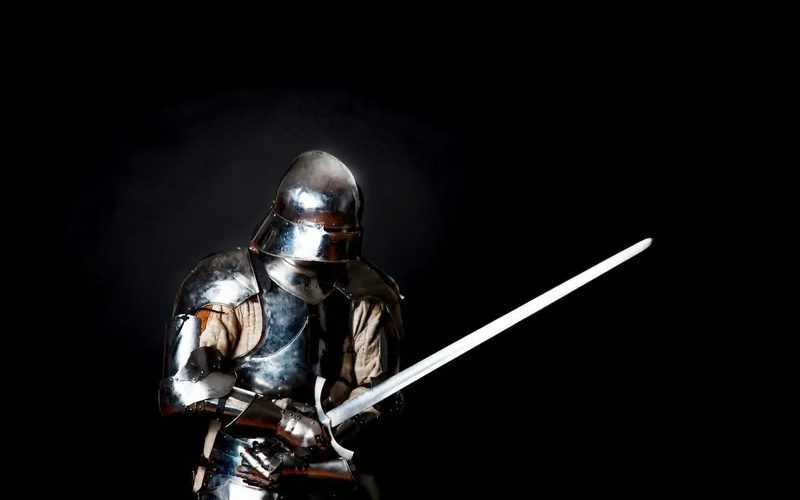
What’s in this article?
During the Middle Ages, the medieval knights wielded their longswords against heavily armored opponents. Most recognized for its cruciform hilt, the longsword was light enough to use one-handed, but the long grip also allowed two-handed use. It suited the military strategies and social environment throughout Europe and eventually became a dueling weapon.
Let us talk about the history of the longsword, its medieval uses, and how it differs from the European greatswords.
What Exactly Is a Longsword?
Today, the term “longsword” refers to all swords lightweight enough to wield in one hand but has a long grip to accommodate two hands. However, the term longsword is relatively modern—not a historical term. Medieval writers used several
For convenience, modern historical fencers use the term longsword, as there is no specific term for the weapon. In German fencing texts, they are the kind of weapons used in the so-called “art of the long
The longsword also served as a sidearm for armored fighting, implying that it was short enough to be able to draw from the belt. Many associate it with the hand-and-a-half sword or bastard sword, which appears in the medieval armory list. However, fencing master Joseph Swetnam described bastard swords as shorter than longswords but longer than the short swords.
Characteristics of Medieval Longsword
The distinguishing characteristic of the longsword was its longer grip rather than its long blade, though most of them had both.
Here are the unique characteristics of the medieval longsword:
Type of Metal
Medieval swords evolved as metallurgy improved. The ideal
Early medieval ironmakers used the bloomery iron-smelting process in charcoal furnaces. Due to a lack of precise control and measuring equipment, medieval blades had varying carbon content and could not match the quality of modern steel.
Construction
Medieval swordsmiths often used slack quenching, where blades were drastically cooled. The process created less brittle but also less hard blades. Some longsword blades had steel edges forge-welded to an iron core.
However, longsword blades were not clay tempered as done with the Japanese katana. Japanese swordsmiths traditionally covered the blade in clay, so the cutting edge was hardened during quenching. In slack quenching, medieval swordsmiths used quenching media like molten lead, boiling water, or olive oil, which did not draw out heat as fast.
Blade Appearance
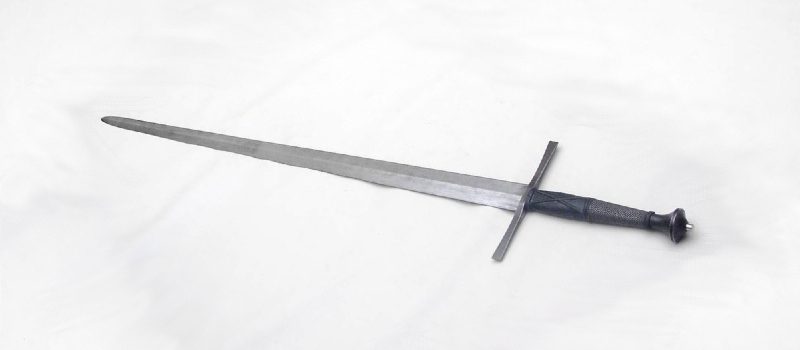
Longswords had symmetrical double-edged blades, which varied in tapering and cross-sections. Earlier
Some had a fuller, which lightened the blade without compromising its structure. Others had diamond cross-sections that stiffened the
Size and Weight
Longswords typically have blades a few inches longer than modern single-handed swords but do not necessarily imply superior reach. The maximum length for longswords was generally limited by what could be drawn from a scabbard. Its blade length may range from 83 to 101 centimeters, while its hilt measures about 17 to 25 centimeters long. Most medieval longswords were reasonably light, weighing around 3 to 4 pounds.
Sword Mounting
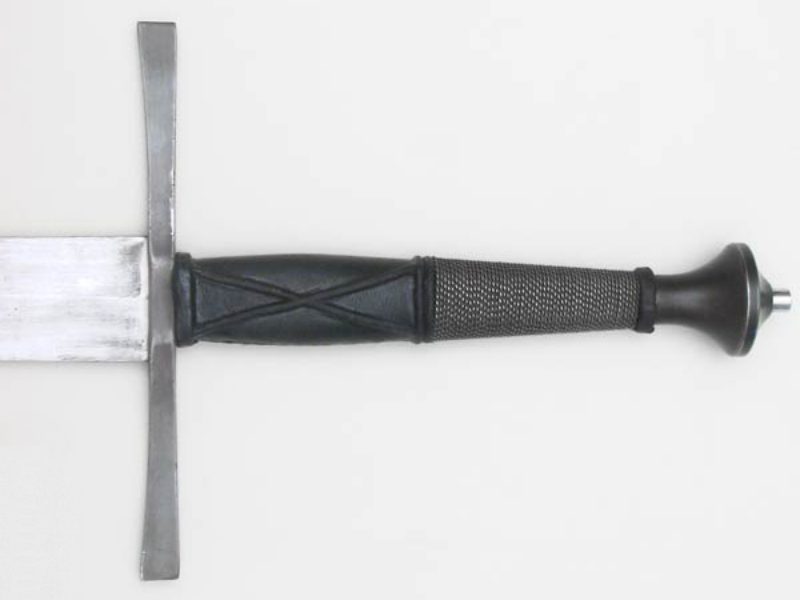
The hilt consists of three parts—the pommel, the grip, and the crossguard—though some might have additional features.
Crossguard
The crossguard protected the hand from an opponent’s
Grip
Instead of a full tang, longswords generally had a narrow tang, sometimes carved into the shoulders of the blade. It generally had a wooden grip, usually hollowed out for the tang. Commonly wrapped in leather and metal wire, the handle may also be polished horn or ivory.
Pommel
The pommel, at the end of the hilt, counterbalanced the weight of the blade. Most longswords had iron or brass pommel, but often not hard steel. Earlier pommels were flat and wheel-shaped, but 15th-century designs featured spherical and fishtail pommels. Some types of swords also featured silvered pommels, sometimes inlaid with decorative glass or enamel.
Scabbards
The knights carried the longswords in scabbard, attached to the skirt of the armor. Medieval art often portrays men carrying swords in their hands without sheaths, which may mean that they discarded them after drawing the
Uses of Longswords in Medieval Times
The knights used the longswords in wars and tournaments, while commoners utilized them in judicial duels. These swords lost their practical use on the battlefield in the late 16th and early 17th centuries but continued as sporting weapons.
On the Battlefield
In 1471, the Burgundian Abbeville ordinance recommended the longswords and daggers as backup weapons for the cavalry. The spearmen and armored knights needed the
In Tournaments
Early tournament weapons were longswords and armor used in actual warfare. During these combats, individual knights or groups challenged specific individuals to fight with sharp weapons. Most foot-combat events utilized the longsword and spears, though competitors wore full armors. By the 14th century, the tournament weapons included blunted swords and lances.
However, tournaments were not necessarily bloodless as several combatants fought to the extreme or à outrance until one party surrendered, was incapacitated, or dead. On the other hand, combat à plaisance showed the skills and bravery of participants without causing serious injury, though many still fought with sharp weapons.
In Judicial Duels
Originating from the early medieval trial by battle, the judicial duel was part of the legal process, usually fought over serious crime. In 1306, the French ordinance allowed judicial duels when a serious crime was punishable by death and there were no witnesses or documents to prove or disprove the matter.
Commoners often fought with longswords, clubs, or shields and wore fighting suits made of greased leather. However, most of them were between craftsmen or townsmen. The elderly, children, women, and clergymen were generally exempted from fighting. Nobles often fought from horseback with lances and on foot with longswords.
In Honor Duels
The honor duels, similar to the classic post-medieval duels fought with rapiers or smallswords, were rarely fought to the death. Medieval nobles engaged in duels when they felt their honor was slighted. These duels were fought in armor, on horseback or on foot usually with spears, longswords, or axes. It was initially legal and public, though some also fought privately.
Types of Longswords
A longsword has both a long grip and a long blade and can be classified into various types, typically by its hilt or blade design. In Historical European Martial Arts (HEMA), the longsword is known by the names bastard sword, hand-and-a-half-sword, estoc, and various other terms.
However, the terminologies for longswords have changed over time. Also, medieval knights and warriors did not make swords fit into specific types, but instead had them in effective forms that would suit the fighting styles of the time.
1. War Swords

The earlier type of longsword was known as the sword of war, the grete war sword, or epee de guerre, and can be traced back to the 1300s. The war swords were carried in battle and usually kept on the saddle rather than worn on the belt. They were efficient for fighting on foot and when mounted.
The war sword had handles long enough to be used in two hands and its largest type was referred to as the great sword—not to be confused with the true Renaissance two-handers, which are widely called today as great swords.
2. Bastard Sword
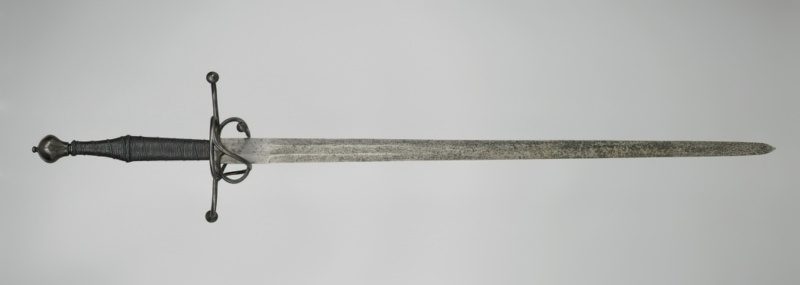
Alternatively called the hand-and-a-half sword, the bastard sword seems to have primarily referred to later longswords with special half-grips and tapering blades. Its bottle-shaped or waisted grips allow using one or two hands, so it’s neither a single-handed nor two-handed sword. Widely used during the 15th and 16th centuries, bastard sword designs ranged from plain cross guards to complex hilts.
3. Estoc
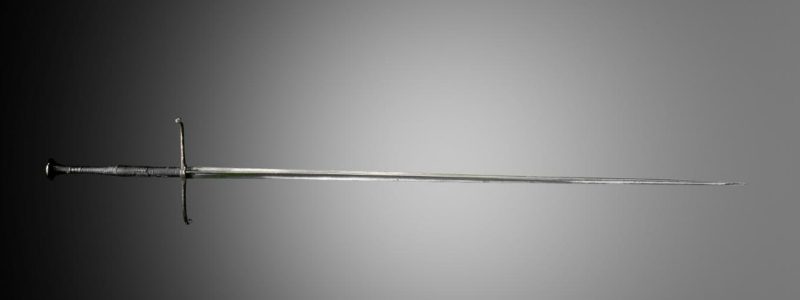
Also called tuck, the estoc was a specialized type of longsword with a very narrow, edgeless blade designed for thrusting into gaps and openings of plate armor. It can be used with one or two hands, with the second armored hand often gripping the blade itself. Cavalrymen used it in the mid to late 16th century.
History of the Longsword
The longsword gradually evolved from the Viking sword and adapted through time. Earlier examples were designed for heavy cutting strokes, while later longswords were more tapered for thrusting into armor. It also became longer both in grip and blade.
In the Late Antiquity
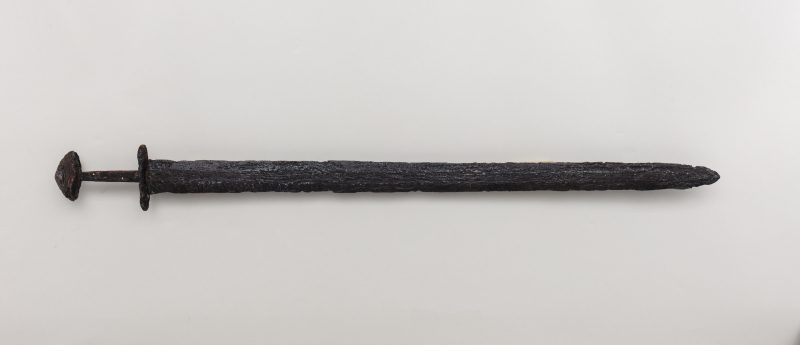
During the Migration period, from the fall of Rome to about the year 1000, the Roman cavalry
In the Middle Ages
By 1000, the Carolingian or Viking swords evolved into the classic knightly
Around 1300, the improvements in metallurgy resulted in better-armored opponents which also required better swords. Some single-handed swords evolved into so-called arming swords or knightly swords with sharply tapered blades efficient for thrusting against armor. Other single-handed swords developed into single-edged falchions with heavy blades efficient for cutting.
The Rise of the Longswords
Longswords appeared around the 1250s, likely to counter better armor, but became most popular from 1370 to 1440. Unlike the single-handed arming
The Decline of Longswords
As swords became impractical on the battlefield, they became part of sports fighting and civilian life. Early tournaments and honor duels utilized longswords. When the armor was no longer practical, the rapier became the civilian dueling weapon.
Early rapiers emerged as cut-and-thrust weapons with broad, double-edged blades. By the 16th century, the rapier was developed for swordplay, featuring long and thin blades. Since they featured an elaborate hilt, they also became fashion items and were worn as part of the civilian dress before being replaced by the smallsword.
Facts About the Medieval Longsword
In medieval weaponry, the term longsword refers to all European swords lightweight enough to use one-handed, but with grips long enough to allow the use of two hands if needed. It was initially developed for armored fighting but eventually became a dueling weapon.
Here are some facts about the medieval longsword:
Medieval states rarely restricted the right to own longswords and other weapons.
Several cities in Italy, Germany, and other regions in Europe depended on citizen militias for defense and required their citizens to equip themselves properly. In some German cities, the average citizen’s skill with longswords was impressive, and every guild member owned several weapons.
The longsword had a longer hilt than an arming sword .

The longsword might have had longer blades than the arming
Many refer to short longswords as bastard swords.

Fencing master Joseph Swetnam described bastard swords as longer than short swords but shorter than longswords. Also known as a hand-and-a-half sword, the bastard
The bastard
Medieval blade designs adapted to military tactics of the time.
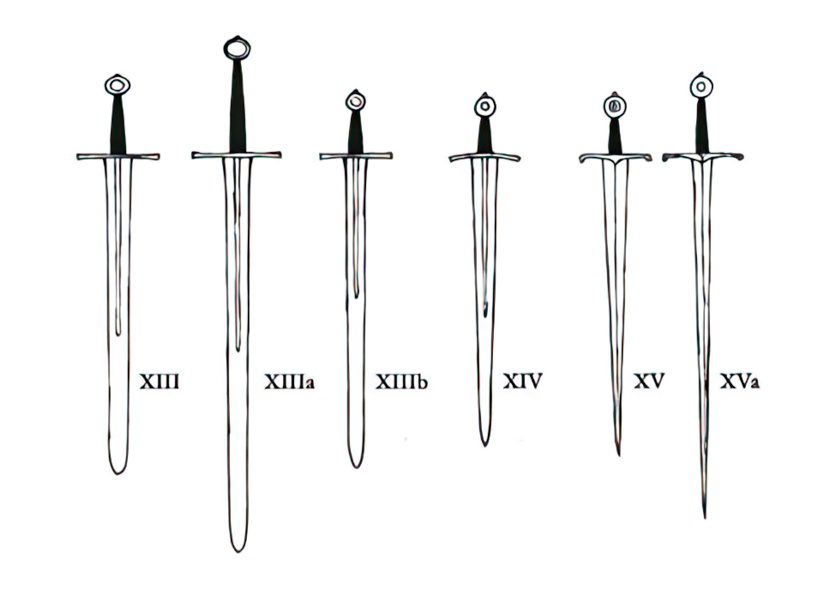
With the emergence of improved armor, medieval swords eventually focused on the blade strength in the thrust rather than the cut. Historian Ewart Oakeshott created the standard typology of medieval swords based on blade form.
Generally, the type XIIIa is not an uncommon longsword blade during the late 13th century. It usually had a fuller and limited tapering, making it ideal for cutting. On the other hand, the type XVa blade of the early 15th century featured a diamond cross-section and was sharply tapered to a thrusting tip.
Training with the longsword began at an early age.
Some medieval writers suggested that boys must train with the longsword aged 12 to 14, alongside other knightly skills and courtly manners. Edward of Woodstock, the Black Prince, fought when he was 16, while King Edward VI of England practiced fencing when he was 13. There were also professional fighting schools where students learned how to use the longsword for an average of five months.
Medieval fight books or fechtbücher served as symbols of wealth and status.
Most fight books—called fechtbücher or singular fechtbuch—were written in German and Italian, often handwritten by professional scribes on parchment. These books served as wealth and status symbols, reflecting the owner’s interest in prestigious knightly activities. Johannes Liechtenauer, the famous German master of the longsword tradition, even wrote using secret and hidden words so not everyone would understand it.
The longswords served as deadly weapons in judicial duels.
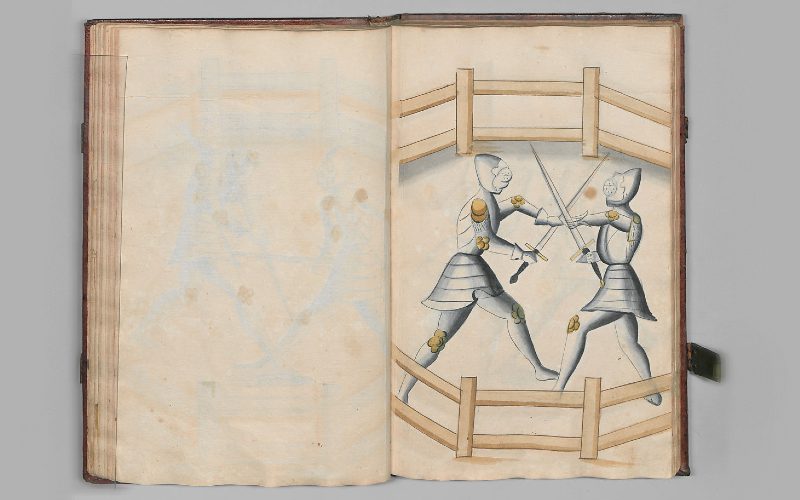
The trial by battle or judicial duel, was the earliest form of dueling and a means to settle accusations of crimes. Several medieval manuscripts portray judicial duels using the German longsword, spear, and spiked shields. Fencing master Hans Talhoffer is known for his lavishly illustrated fight books, widely reproduced in modern times.
Fighters demonstrated longsword techniques with federschwerter.
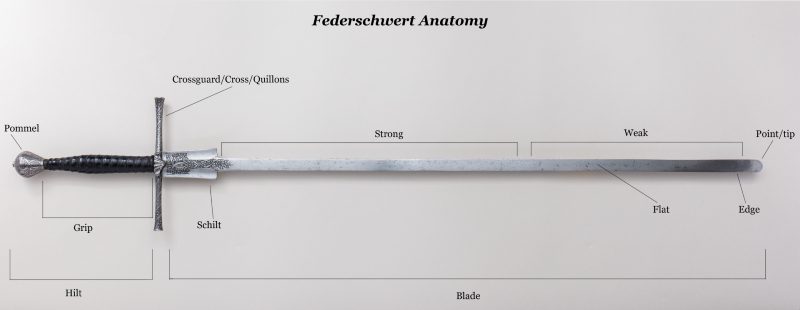
The federschwerter, German for feather swords, were practice swords associated with the German Fechtschulen sport fighting. By the 16th century, the middle class who were unlikely to own armor used it as a sports weapon. These swords had thick edges and blunt or foiled tips, but could also cause injuries or death. Fighters demonstrated longsword techniques with federschwerter, usually until one participant bled or was blinded.
Unarmored combat was the foundation of longsword techniques.
Several fight books teach several sets of longsword techniques suited for fighting unarmored, fighting in armor, and fighting from horseback. The bare fighting or blössfechten refers to an unarmored combat technique that remained a martial sport into the 16th century, even after the longswords disappeared from the battlefield.
Unlike the longsword, the great sword is too large to be worn on the belt.
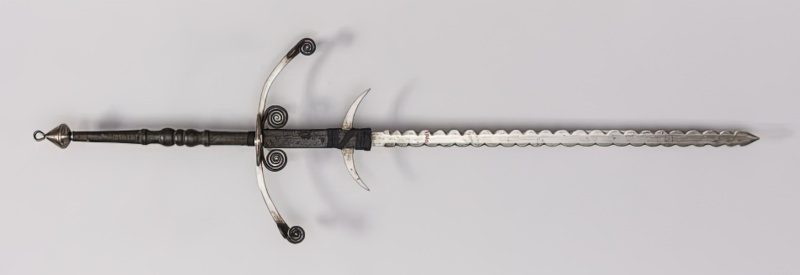
The term great sword may mean different things to different cultures, but it generally had a massive blade length, roughly the height of a man. The most popular is the zweihander or bidenhander of the German Landsknechts, who carried it over the shoulder like a halberd. The German two-handers had an overall length of about 150 to 175 centimeters.
Conclusion
Long enough to be gripped with both hands, the medieval longsword was an efficient weapon in armored fighting in battlefield, judicial dueling, and tournaments. Unlike greatswords, the longsword was surprisingly light and suitable for thrusts and cuts. Today, it remains one of the most popular weapons associated with knights and battles of the Middle Ages.





